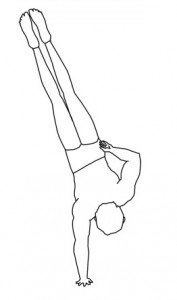Different groups of people practice hand balancing for different reasons.

Handstand in Yoga
– Within the multitude of yoga asanas there are quite a few hand balancing poses. In yoga these are mostly known as inversions, as that is exactly what they are doing, inverting the body. Many of the poses are the same like the headstand, handstand and crow stand (aka frogstand) although they often come in different names. Others use various components of yoga like the lotus position in a handstand which isn’t seen outside of yoga too often.
When doing hand balancing in yoga, as in all yoga the goal, is to hold the pose, usually for longer periods of time. (I know this is a simplification.) To balance and go inside, as yoga is more than a physical practice.
Break Dancing – Breakdancing incorporates a number of hand balancing movements. Again these come in all different names. In break dancing moves are rarely held for a long time instead movements are strung together and made to flow.
Often in these balances break dancers will contort their body in order to hold the balance. This gives their balances a different look then the other disciplines. Make no doubt about it, great break dancers have great skill and strength.
Circus Performers – The circus has a wide range of skills and many of the incorporate hand balancing at one time or another. Contortionists, acrobats, even jugglers go into various hand balances. Then of course, there are the equilibrists, the best of the best. The hand balancing they do is the best in the world and awe inspiring to watch.
In order to get to this level you will need professional coaching, and many hours over years of practice.
Bodyweight Trainees – This is how I came to hand balancing. Working out in various ways I came to use my own bodyweight as my primary means of resistance. This led to doing handstands and eventually handstand pushups against the wall. One day I thought it would be fun to do it all without the wall and that led to my first attempts at doing a freestanding handstand. Hand balancing goes well with any variety of strength training.
Gymnasts – Probably the most well known and even biggest group of hand balancers. Their balances are done with a perfectly straight body to score good with the judges (and many think if you do it any other way you are doing it wrong and/or going to hurt yourself).
In a lot of gymnastics the skills move into and out of the handstand but specific hand balancing skills aren’t practiced all that often. In order to do a one arm handstand a gymnast will have to work outside of the normal gymnastic skills. But you can’t deny the best gymnasts are some of the strongest and most skilled people out there.
Everyday People – Then there is just your average person who wants to do a handstand. Maybe these other categories inspired them to want to do so. Maybe the idea came from somewhere else. You don’t have to fit into one of these groups to get good although just working on the basic movements is often enough for many people. Being able to hold a handstand with ease is the end goal. But some choose to keep pursuing what they can do in hand balancing.
No one group of people is better than any other. They can all learn from one another. They can all pursue what they want in their own way. Here at Lost Art Of Hand Balancing I hope to offer something to everyone regardless of their goals.
For your average person looking to get started the Secrets of the Handstand DVD would be the best place to start.
Someone looking to expand their repertoire would want to check out The True Art and Science of Hand Balancing or the Hand Balancing Mastery Course to discover tons of new and advanced skills.
An expert or professional may have skills beyond these materials but maybe they could use a pair of hand balancing stands.
And this doesn’t even begin to cover the acrobatic arts outside of handbalancing that are closely related.
If you’ve read this far why don’t you comment below and tell me what brought you to hand balancing in the first place?
Good Luck and Good Hand Balancing,
Logan Christopher







 As was
As was 
 “This does not mean that you must be able to perform all of the hundreds of tricks in my basic course “Handbalancing Made Easy”. It simply means that you must be able to press into a perfect Two-Hand Handstand and hold it with absolute control. It means that your elbows must be straight and locked, that your shoulders must be stretched out and locked, that your back must be only slightly arched, your knees perfectly straight and your toes pointed.
“This does not mean that you must be able to perform all of the hundreds of tricks in my basic course “Handbalancing Made Easy”. It simply means that you must be able to press into a perfect Two-Hand Handstand and hold it with absolute control. It means that your elbows must be straight and locked, that your shoulders must be stretched out and locked, that your back must be only slightly arched, your knees perfectly straight and your toes pointed.






